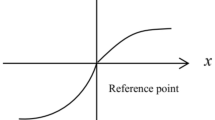Abstract
This paper proposes a quantitative evaluation algorithm based on a comprehensive analysis of material’s shape, texture, color, style, and other characteristics using indoor wireless networking design and cloud data to improve the application effectiveness of ecological environment materials. It also adopts a data-driven method to quantitatively evaluate the application effectiveness of ecological environment materials using indoor wireless network design based on preliminary feature information. Specifically, this work reconstructs the feature space of ecological environment materials by extracting dimensionality features related to the quantitative evaluation, and analyzes the mutual information features of big data fusion. Moreover, a quantitative regression analysis and statistical model construction is used to evaluate the application effectiveness by using preliminary feature information as a constraint condition. In addition, this study employs the spatial effect element feature analysis method to quantitatively analyze and rigorously test the application effectiveness assessment. The empirical results show that the proposed quantitative evaluation algorithm has good accuracy and high reliability, which can effectively improve the application quality of ecological environment materials in indoor wireless network design.









Similar content being viewed by others
Availability of data and material
The data used to support the findings of this study are available from the corresponding author upon request.
References
Zhen, Z., & Jianwei, B. (2022). Aesthetic evaluation of indoor wireless network design based on visual features. International Journal of Mobile Computing and Multimedia Communications (IJMCMC), 13(2), 1–12.
Maciej, S., et al. (2021). Mycelium-based composites in art, architecture, and indoor wireless network design: A review. Polymers, 14(1), 145–145.
Dan, L. (2021). Characteristics and advantages of indoor wireless network design. Journal of Architectural Engineering Technology, 10(11), 1–1.
Jialin, Y. (2021). Research on the effect of light and shadow in computer-aided Indoor wireless network design. Journal of Physics: Conference Series, 2074(1), 57–70.
Yuan, J. (2022). The application of rural decorative materials in indoor wireless network design. International Core Journal of Engineering, 8(1), 21–24.
Liang, J. (2021). environmental function evaluation and preparation of green decorative materials in indoor design. ACSM, 45(5), 423–430.
Hongzhou, P., & Hongmin, S. (2021). Application of Bambusa emeiensis and its derivative materials in indoor wireless network design. Journal of Physics: Conference Series, 2044(1), 93–104.
Studyanto, A. B., Purwasito, A., Warto, et al. (2021). Eco-friendly materials in indoor wireless network design of Pecel Solo restaurant. IOP Conference Series Earth and Environmental Science, 905(1), 012048.
Su, X. (2021). Function of nano-decorative materials in indoor wireless network design and the application of ecological and environmental protection concepts. Ferroelectrics, 580(1), 268–282.
Wang, Y., Zhu, Y. M., Yu, M. J., et al. (2020). Quantitative evaluation and spatial differentiation of ecoenvironmental livability in Zhejiang Province, China. Journal of Mountain Science, 17(6), 1491–1508.
Chang, Y. S, Hu, K. J., Chiang, C. W., et al. (2020). Applying mobile augmented reality (ar) to teach indoor wireless network design students in layout plans: evaluation of learning effectiveness based on the ARCS Model of Learning Motivation Theory. Sensors (Basel, Switzerland), 20(1).
Grenda, K., Gamelas, J., Arnold, J., et al. (2020). Evaluation of anionic eco-friendly flocculants prepared from eucalyptus pulps with diverse lignin contents for application in effluent treatment. Polymers, 13(1), 25.
Xiao, Su. (2021). Function of nano-decorative materials in indoor wireless network design and the application of ecological and environmental protection concepts. Ferroelectrics, 580(1), 268–282.
Qiang, C. (2021). Application of environmental protection decoration materials in architectural design and urban planning and design. IOP Conference Series: Earth and Environmental Science, 760(1), 21–24.
Feiyan, G. (2020). Application of energy-saving, environmental protection and green decoration materials in construction. BASIC & CLINICAL PHARMACOLOGY & TOXICOLOGY, 126, 170–170.
Acknowledgements
The paper did not receive any financial support
Author information
Authors and Affiliations
Corresponding author
Ethics declarations
Conflict of interest
Declares that he has no conflict of interest.
Additional information
Publisher's Note
Springer Nature remains neutral with regard to jurisdictional claims in published maps and institutional affiliations.
Rights and permissions
Springer Nature or its licensor (e.g. a society or other partner) holds exclusive rights to this article under a publishing agreement with the author(s) or other rightsholder(s); author self-archiving of the accepted manuscript version of this article is solely governed by the terms of such publishing agreement and applicable law.
About this article
Cite this article
Zhu, Zj. Indoor evaluation algorithm for ecological environment design materials based on cloud data processing and wireless communication. Wireless Netw 30, 37–50 (2024). https://doi.org/10.1007/s11276-023-03447-w
Accepted:
Published:
Issue Date:
DOI: https://doi.org/10.1007/s11276-023-03447-w




